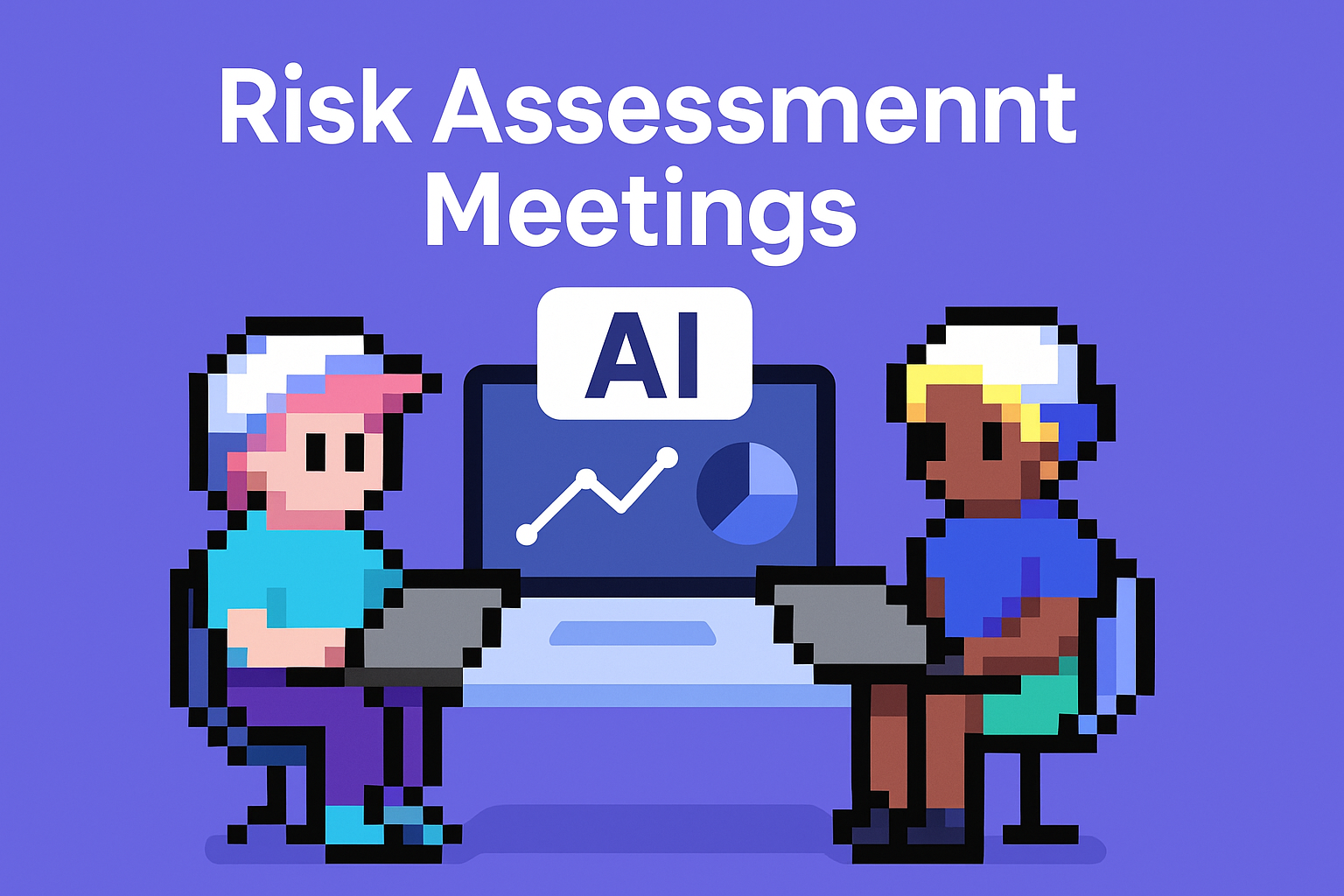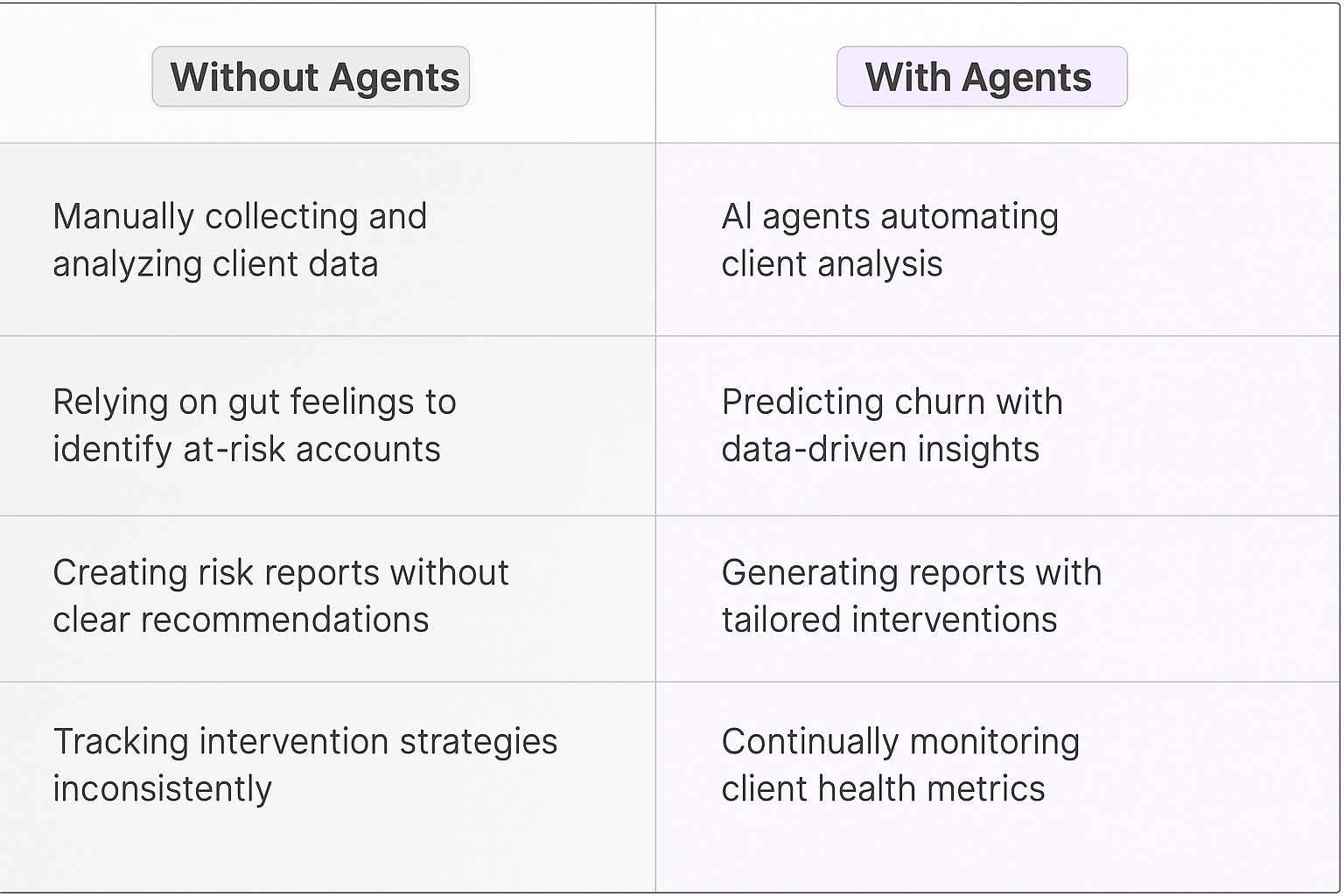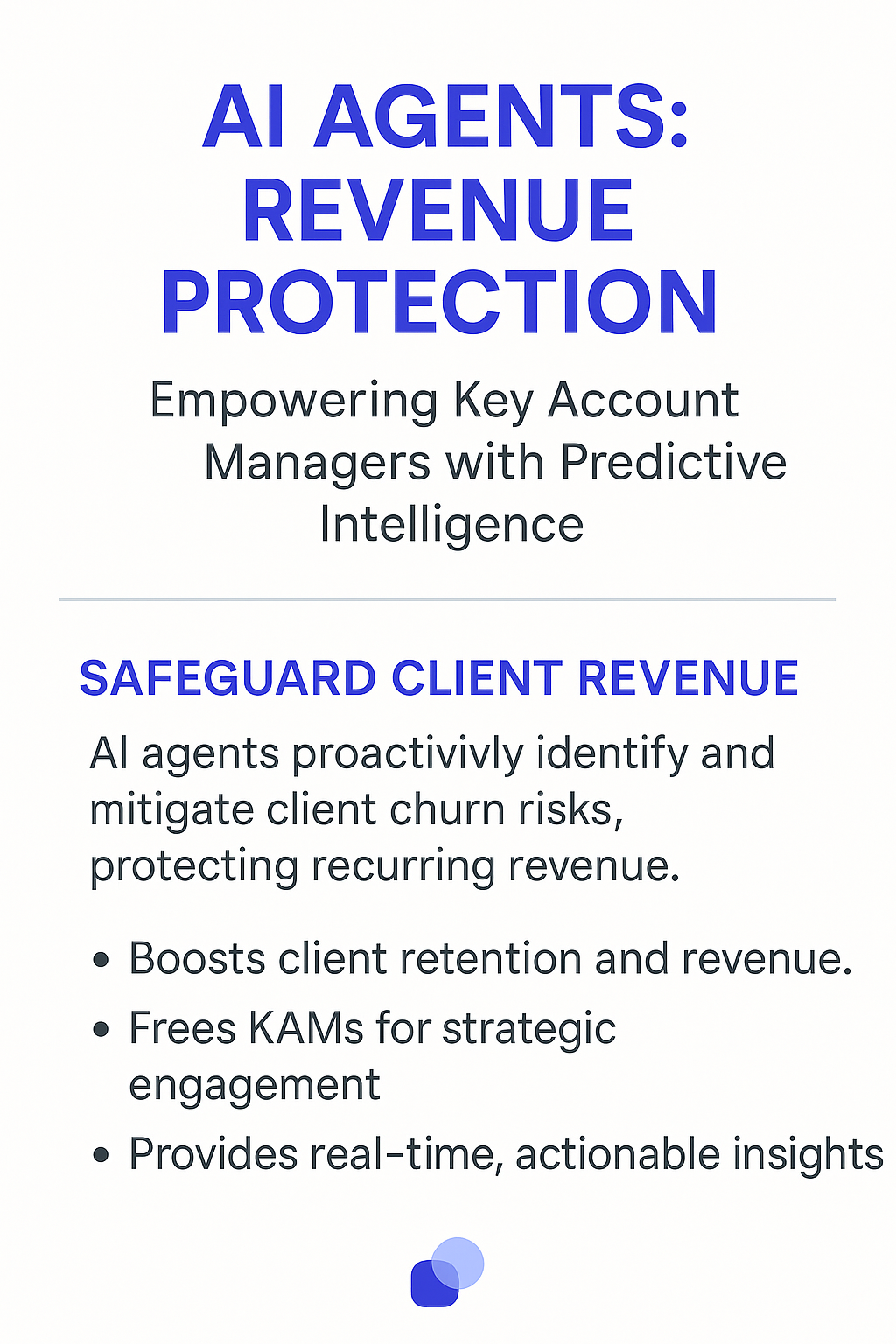
AI-powered meeting planner agents are revolutionizing how key account managers conduct risk assessments, enabling them to proactively identify and mitigate potential threats to client relationships and recurring revenue. These agents automate the tedious aspects of data collection and analysis, allowing managers to focus on strategic decision-making and effective intervention strategies. This technology streamlines workflows, reduces churn risk, and enhances overall account management effectiveness.
Before Meeting
Your AI agent compiles a comprehensive risk report, highlighting key warning signs such as declining usage, delayed payments, or organizational changes. You enter the meeting with a clear understanding of potential threats and their impact on renewal probability.
During Meeting
As you discuss potential risks, your AI agent provides real-time insights, suggesting intervention strategies based on similar historical cases and predicting the potential impact of each approach. This enables data-driven decision-making and collaborative problem-solving.
After Meeting
Post-meeting, your AI agent tracks the implementation of intervention strategies, monitors client health metrics, and provides ongoing updates on risk levels. This ensures accountability and enables timely adjustments to protect valuable accounts.
What you’ll need
You don't need to be a developer to set up this integration. Follow this simple guide to get started:
- Meeting Notetaker Agent template
- Calendar account
- Meetings to join
- Relevance AI Account

Who this agent is for
This agent is designed for key account managers, customer success managers, sales directors, and anyone responsible for managing client relationships and securing renewals. It's ideal for individuals and teams who need to proactively identify and address potential risks that could lead to churn or revenue loss. Whether you're managing a portfolio of strategic accounts or overseeing a team of account managers, this agent simplifies risk assessment and enables data-driven decision-making.
How this agent makes meeting planning easier
Automate data collection and analysis
Instead of manually gathering and analyzing client health metrics, the agent automatically monitors key indicators such as usage, engagement, and satisfaction scores. This saves significant time and ensures that you have a comprehensive view of each client's health.
Predict potential churn
The agent uses machine learning algorithms to analyze historical data and predict the likelihood of churn prediction for each client. This allows you to proactively identify at-risk accounts and develop targeted intervention strategies.
Generate risk reports with actionable insights
The agent generates comprehensive risk reports that highlight key warning signs, quantify risk levels, and provide actionable insights for addressing potential issues. This ensures that you have the information you need to make informed decisions.
Recommend specific intervention strategies
Based on similar historical cases, the agent recommends specific intervention strategies that are most likely to be effective in mitigating risks and protecting valuable accounts.
Benefits of AI Agents for Key Account Managers
What would have been used before AI Agents?
Key account managers traditionally relied on manual data collection, gut feelings, and anecdotal evidence to assess client risks. This process was time-consuming, subjective, and prone to errors. They would spend valuable time gathering data from various sources, analyzing spreadsheets, and conducting interviews, taking away from their core responsibilities of building relationships and driving revenue.
What are the benefits of AI Agents?
AI agents offer a streamlined and data-driven approach to risk assessment, freeing up key account managers to focus on strategic decision-making and effective intervention strategies. The most significant benefit is the time saved by automating data collection and analysis. The agent handles everything from monitoring client health metrics to predicting churn probability, reducing the administrative burden on the manager.
AI agents also minimize subjective bias by providing objective risk assessments based on historical data and machine learning algorithms. This ensures that decisions are based on facts rather than assumptions. Furthermore, the agent improves communication by providing clear and concise risk reports with actionable insights, keeping all stakeholders informed and engaged.
By recommending specific intervention strategies based on similar historical cases, the agent provides valuable guidance and increases the likelihood of successful outcomes. This empowers key account managers to take proactive measures and protect valuable accounts. Ultimately, AI agents enhance productivity, reduce churn risk, and allow key account managers to focus on building strong client relationships and driving revenue growth.
Traditional vs Agentic meeting planning
Traditionally, key account managers spent hours each week manually collecting and analyzing client data. Now, AI agents automate this, freeing up time for strategic planning. Before, identifying at-risk accounts relied on gut feelings and anecdotal evidence. With an agent, churn probability is predicted based on data-driven insights. Risk reports used to be time-consuming to create and often lacked actionable recommendations. Now, they're generated automatically with tailored intervention strategies. Finally, tracking the effectiveness of intervention strategies was a manual and often inconsistent process. The agent monitors client health metrics and provides ongoing updates on risk levels.

Tasks that can be completed by a Meeting Planner Agent
Key account managers juggle numerous tasks, from building relationships with clients to negotiating contracts and driving revenue growth. A meeting planner agent can handle many of the administrative tasks associated with risk assessment meetings, allowing managers to focus on their core responsibilities.
Monitoring Client Health Metrics
The agent continuously monitors key indicators such as usage, engagement, and satisfaction scores to identify potential warning signs.
Predicting Churn Probability
The agent uses machine learning algorithms to analyze historical data and predict the likelihood of churn for each client.
Generating Risk Reports
The agent generates comprehensive risk reports that highlight key warning signs, quantify risk levels, and provide actionable insights.
Recommending Intervention Strategies
Based on similar historical cases, the agent recommends specific intervention strategies that are most likely to be effective.
Tracking Intervention Effectiveness
The agent monitors client health metrics and provides ongoing updates on the effectiveness of implemented intervention strategies.
Scheduling Follow-Up Meetings
The agent can schedule follow-up meetings with clients and internal stakeholders to discuss progress and address any remaining issues.
Updating CRM Records
The agent can automatically update CRM Records with relevant information from risk assessment meetings, ensuring that all stakeholders have access to the latest data.
Sending Automated Reminders
The agent can send automated reminders to key account managers and other stakeholders to ensure that they are aware of upcoming meetings and deadlines.

Things to Keep in Mind When Building a Meeting Planner Agent
Building an effective meeting planner agent requires careful planning and attention to detail. The goal is to create an agent that seamlessly integrates with your existing workflows and provides a user-friendly experience for all participants.
Define Clear Objectives
Before you start building your agent, define clear objectives for what you want it to achieve. Do you want to reduce churn risk, improve client retention, or increase revenue growth? Having clear objectives will help you prioritize features and measure success.
Integrate with Existing Systems
Ensure that your agent integrates seamlessly with your CRM, marketing automation platform, and other relevant systems. This will allow you to access the data you need and automate key tasks.
Prioritize Data Security
Protect sensitive client data by implementing robust security measures. Ensure that your agent complies with all relevant data privacy regulations.
Automate Notifications and Alerts
Configure the agent to send automated notifications and alerts when potential risks are detected. This will allow you to take proactive measures and prevent issues from escalating.
Provide Customizable Settings
Allow users to customize the agent's settings to match their preferences. This might include setting preferred risk thresholds, specifying notification preferences, and choosing which data sources to monitor.
Test Thoroughly
Before you roll out the agent to your entire team, test it thoroughly to ensure that it is working correctly and that it meets your objectives. Gather feedback from users and make any necessary adjustments.
Continuously Improve
Once your agent is live, continue to monitor its performance and gather feedback from users. Use this information to identify areas for improvement and make ongoing enhancements.
The Future of AI Agents in Meeting Planning
The future of AI agents in meeting planning is bright, with advancements in natural language processing, machine learning, and artificial intelligence promising to further streamline and enhance the risk assessment process. Future agents will be able to understand complex client interactions, anticipate potential issues, and proactively suggest solutions.
AI agents will also become more personalized, learning individual client preferences and tailoring their recommendations accordingly. They will be able to identify preferred communication styles, preferred intervention strategies, and even preferred meeting times, creating a more seamless and user-friendly experience.
Furthermore, AI agents will play a larger role in facilitating collaboration and communication during meetings. They will be able to transcribe meeting minutes, track action items, and even provide real-time sentiment analysis, making meetings more productive and inclusive.
AI agents will also integrate with other business applications, such as project management tools and customer support systems, providing a holistic view of client-related activities and enabling better decision-making.
Ultimately, the future of AI agents in meeting planning is about creating intelligent systems that not only automate the risk assessment process but also enhance collaboration, improve communication, and drive better business outcomes.









